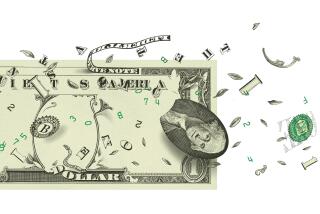Q & A : Ghosts of Markets Past Cry ‘Logic’
- Share via
It’s the end of the year--time for everyone to come clean, total up your victories and losses in life, and vow to do better in 1992. With that in mind, the Market Beat column here turns a critical eye on itself, looking back on investment themes that filled this column during 1991 and how they played out--for better or worse. Q. OK, Mr. Market Beat, let’s take it back to the beginning: Did you and your “experts” forecast stocks’ explosive rally when the Gulf War began last January?
A. Nope--and there’s a good lesson there. Most people on Wall Street, us included, believed that stocks would rally after victory was certain. But the market proved once again that it rarely caters to the majority’s wishes: Rather than wait for victory, stocks soared the day after the shooting started on Jan. 16 and never looked back.
Q. How did you atone for missing something so obvious?
A. By remembering early on another important market rule: Don’t fight the tape (as in stock ticker tape). When a rally gets going with a lot of force, you can’t argue with it. You just have to get on board. So when the Dow Jones industrial average was at 2,788 on Feb. 5, up nearly 300 points from its prewar low, we noted three convincing signs that a new bull market was beginning: Rising stocks were swamping losers daily; trading volume was huge, and small stocks were leading the pack.
Q. And what about those small stocks--did you honestly believe in that rally?
A. Yes, that seemed like the real thing last winter, even though many analysts were arguing that it was yet another false start for small stocks, which had been in a funk since 1983. The March 11 column was headlined: “Small Stocks: Ease In Over Time, Diversify.” Some of the small-stock mutual fund managers quoted then had some very good advice.
Q. Would you like to give us a for-instance?
A. Stu Roberts, who runs the Montgomery Securities Small-Cap fund in Denver, made a great call on motorcycle maker Harley-Davidson. The stock was $29 on March 11. It’s $37.375 now, and traded as high as $60.75 last summer.
Also, Jack Granahan, manager of the Vanguard Explorer fund in Waltham, Mass., reminded in that column that you shouldn’t be afraid to sell small stocks when they produce windfall profits for you overnight, which happened frequently this year. He was cutting back on computer networker SynOptics Communications then, after the stock had rocketed from $10.50 to $49.25 in less than a year. It’s now $19.50.
Q. As we recall, some small-stock ideas in that column bombed too.
A. You bet. David Evans of Robertson Stephens Emerging Growth fund in Avon, Conn., picked California women’s apparel retailer Wet Seal, then at $15.75. Living in Connecticut, he couldn’t know how tough the economy was getting out here. Wet Seal now is at $7.625, a reflection of California’s deep consumer recession. Losers like that remind you why it’s so crucial that investors diversify.
Q. Let’s talk biotech, a big 1991 story. You defended Thousand Oaks-based biotech firm Amgen last March, when the stock was at $32 and some bears argued that it was way overpriced. What happened with that?
A. The stock now is at $60.25. But honestly, defending Amgen at $32 almost seemed like a lay-up. The bears were arguing that biotech stocks were overpriced, which maybe they were and still are. But Amgen was (and is) one of the few biotech firms actually making money. People who attacked Amgen weren’t using their noodles: Simple logic dictated that the firm’s healthy profit growth was going to draw investors like flies.
Q. In the unpredictable market that investors have endured this year, you want to tell us that logic is a good investment tool? Some people would say you’re out to lunch.
A. Well, when we look back on the investment themes that worked this year, logic seemed to play a key role every time. For example, we argued last spring for investing in Latin American stocks, because the theme was only beginning to be talked up on Wall Street, and the economic news coming from the region was encouraging.
Mexico was a favorite, because of the potential economic miracle that President Carlos Salinas de Gortari was engineering. Logically, you had to figure that the Mexico/Latin America story was just starting to get hot with U.S. investors. Sure enough, stock in the Latin American Fund (traded on the New York Stock Exchange) has risen from $14.25 last spring to $24.625 now. And Telefonos de Mexico, the Mexican phone monopoly, has surged from $27.375 last May 15 (when we first wrote about it) to $42.125 now.
Q. That might have been as much luck as logic, but go on.
A. Logic also dictated all year that the only possible course for interest rates was down, because the economy wasn’t going to grow quickly no matter what the Federal Reserve or the White House said. So we tried to encourage people to invest in longer-term CDs and bonds last winter, spring and summer. Little did we know just how low rates would go!
A few other logical Market Beat calls that worked: Selling technology stocks late last April, when Compaq and other key players gave early warnings of slowing sales; buying electric utilities last May, because they were natural beneficiaries of lower interest rates; avoiding oil stocks last June, when gasoline price wars broke out, and buying toy giant Mattel in mid-September, as CEO John Amerman began meeting with money managers here and in Europe to explain misunderstood Mattel’s tremendous growth prospects. Mattel stock was $22 then; it’s $28.875 now.
Q. Well, you know what they say about hindsight being 20-20. How about the investment themes that didn’t work?
A. We had our share in 1991, for sure. But again, when an idea didn’t work, it was most often where logic should have told us that something was inherently wrong with the idea--we were ignoring something right under our nose.
Last March, we saw a growth company in International Technology Corp., a Torrance-based hazardous-waste cleanup firm. But the whole industry was slowing, and against that backdrop it didn’t matter that the stock looked cheap at $10.625. It’s now $6.875.
Likewise, it was dumb to suggest last August that BankAmerica stock was quickly going to $50 or $60 after it ran up to $43.375 on the announcement of its merger with Security Pacific. We knew California’s economy was in trouble; BankAmerica wasn’t going to escape the pain. The stock now is $33.50.
Finally, when the market mysteriously knocked shares of David Murdock’s Dole Food from $48 to $41 last fall, logic told you that somebody somewhere knew trouble was brewing. It would have been better to avoid the stock, but we thought that it looked appealing at $41. A disastrous quarterly earnings report proved that the sellers were right. Dole now is at $34.75.
Q. So what’s the big lesson from 1991--that if more investors just used logic, they wouldn’t need Market Beat or any other alleged experts?
A. We wouldn’t say it exactly that way--but maybe you’re on to something.
More to Read
Inside the business of entertainment
The Wide Shot brings you news, analysis and insights on everything from streaming wars to production — and what it all means for the future.
You may occasionally receive promotional content from the Los Angeles Times.










